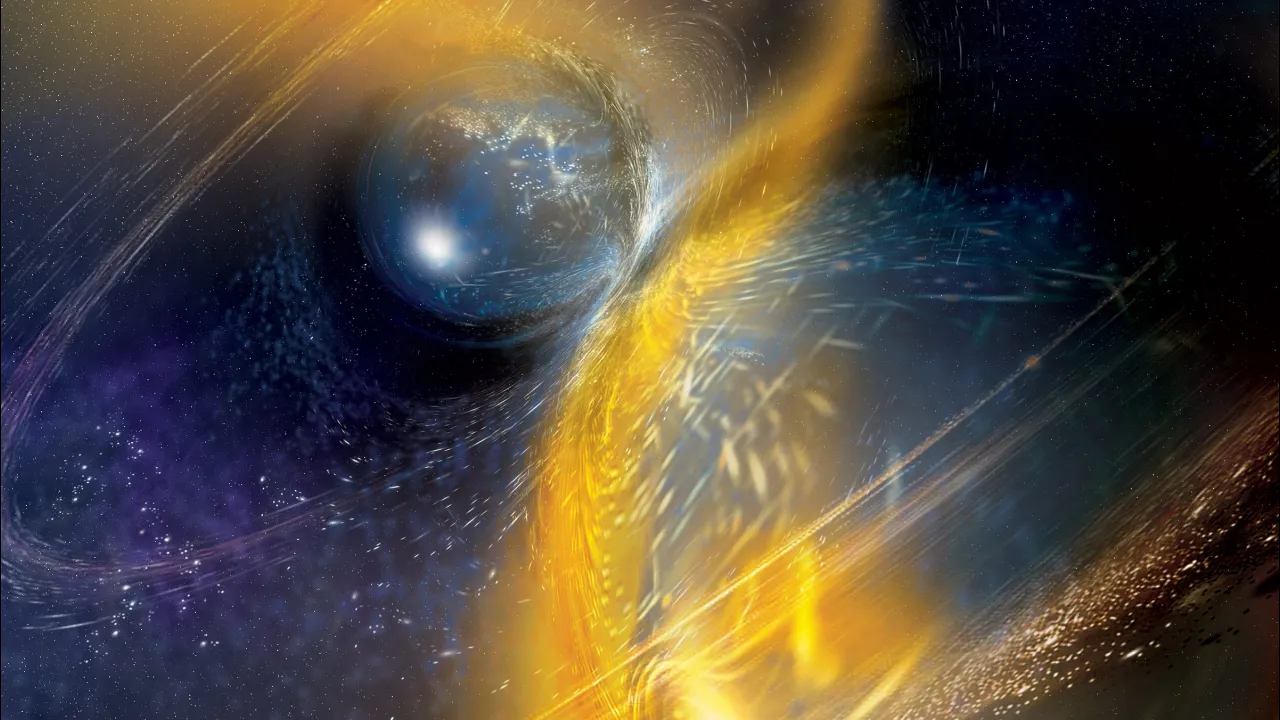Gravitational waves don't arrive simultaneously with light.
"In 2017, a kilonova sent light and gravitational waves across the Universe. Here on Earth, there was a 1.7 second signal arrival delay. Why?"
(BigThink.com/Light and gravitational waves don’t arrive simultaneously)
The gravitational waves from the kilonova in 2017 arrived 1,7 seconds before visible light. The reason. Researchers might find the answer to the question of why that thing happened and why gravitational waves arrived before visible light from a "Flamingo" simulation. The simulation is meant for a universal model of the object and its magnetic field interaction with the material. All quantum fields interact similarly. And that simulation can give a hint that maybe gravitational wave comes closer than light.
The Flamingo-simulation
There are three possibilities as to why light comes after the gravitational waves.
1) Gravitational waves come from different places than visible light. One suggestion is dark matter dense around gravitational centers. If the impact wave that leaves from kilonova has a high enough density that thing can interact with dark matter. In some models. There is a remarkable mass of dark matter inside neutron stars.
And collisions between those things cause an effect where that impact resonates with dark matter. In this model, gravitational waves are the result of the interaction between dark matter particles.
2) The expanding shockwave that travels slower than the speed of light closes the light inside it. The shockwave cannot close gravitational waves inside it, and that causes an effect where light seems to travel slower than gravity waves.
3) The third possibility is the most fascinating. A gravitational wave is an expanding gravitational field. When the gravitational field's expansion is fast enough the gravitational wave just sheds from the main gravity field. And gravity wave is traveling gravitational field.
It's possible that when gravitational waves harvest energy from a kilonova explosion they could travel faster than light. The gravitational wave should induct gravitational fields into other particles. Also, it can slow the speed of photons. If another gravitational field is not slowing the gravitational wave. That causes gravitational waves can travel faster than light in certain circumstances.
In models, an extremely strong gravitational field pulls other energy fields to the gravitational center. When gravitational-wave impact those electromagnetic waves their energy level rises. In the kilonova explosion high energy level causes the situation. That gravity field starts to turn stronger. And when that energy production ends the gravitational fields start to shrink. In that case, the most out layer of the gravitational field just rips itself off the entirety.
******************************************************************************
"One of the most fascinating, but also most rare, events in all of the Universe is the inspiral and merger of two neutron stars, which sometimes leads to a kilonova event. In 2017, such an event occurred, and the signals were detected here on Earth by both light-sensitive observatories like NASA's Fermi satellite, as well as the gravitational wave detectors LIGO and Virgo. Even though both light and gravitational waves were generated by this event, and they both travel at the same speed, the gravitational waves stopped arriving 1.7 seconds before the first light was seen. Science investigates the reason why."
https://bigthink.com/starts-with-a-bang/light-gravitational-waves-arrive/
*****************************************************************************
In kilonovas, the temperature rises to an extremely high level. The high temperature means that the energy level in those impacts is very high. And that high energy impact turns gas and dust into the heaviest elements like gold and even uranium. There is always a dark matter ball or density around all gravitational centers. And in extremely high energy levels is possible. That the electromagnetic radiation interacts directly with dark matter.
In those explosions, the electromagnetic wave movement turns so tight that it can push dark matter. In the "Flamingo"-image you can see the double-ring. Near very dense and heavy objects those double rings can be so high energy that they can push straight the dark matter. The reason why this model is interesting is that there is a black hole that is forming after a neutron star collision. And that massive gravitation slows light.
So the reason why gravitational waves arrive on Earth before light could be that the gravitational wave source is in a different place than visible light. Another reason for that thing could be the pressure or shockwave that travels out from Kilonova. In that case, the shockwave forms a bubble that travels slower than light. In that case, the shockwave closes the light inside it. The shockwave will not close gravitational waves inside it. And that causes a situation, where light comes to Earth after the gravitational waves.
https://bigthink.com/starts-with-a-bang/light-gravitational-waves-arrive/
https://interestingengineering.com/science/computer-simulation-universes-matter-mystery





No comments:
Post a Comment
Note: Only a member of this blog may post a comment.